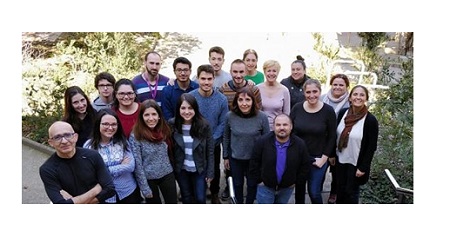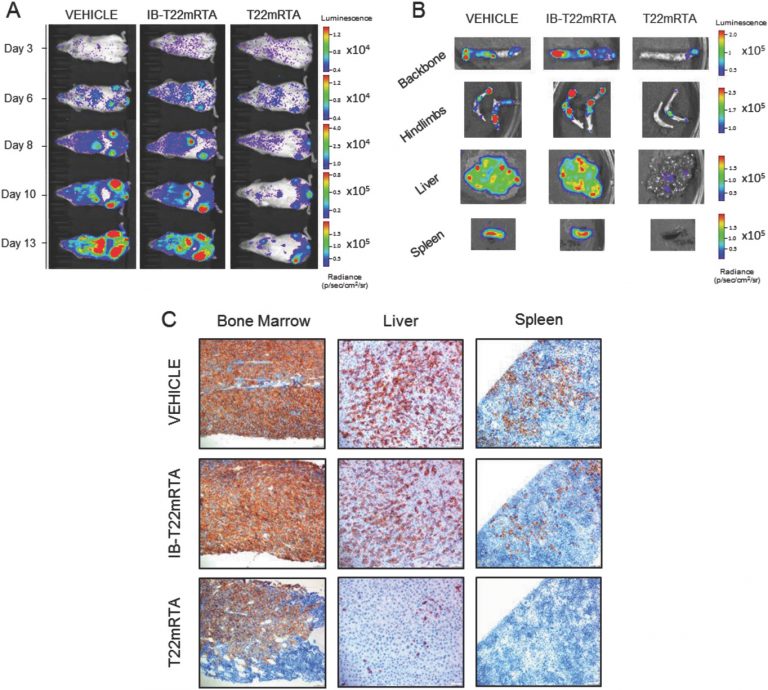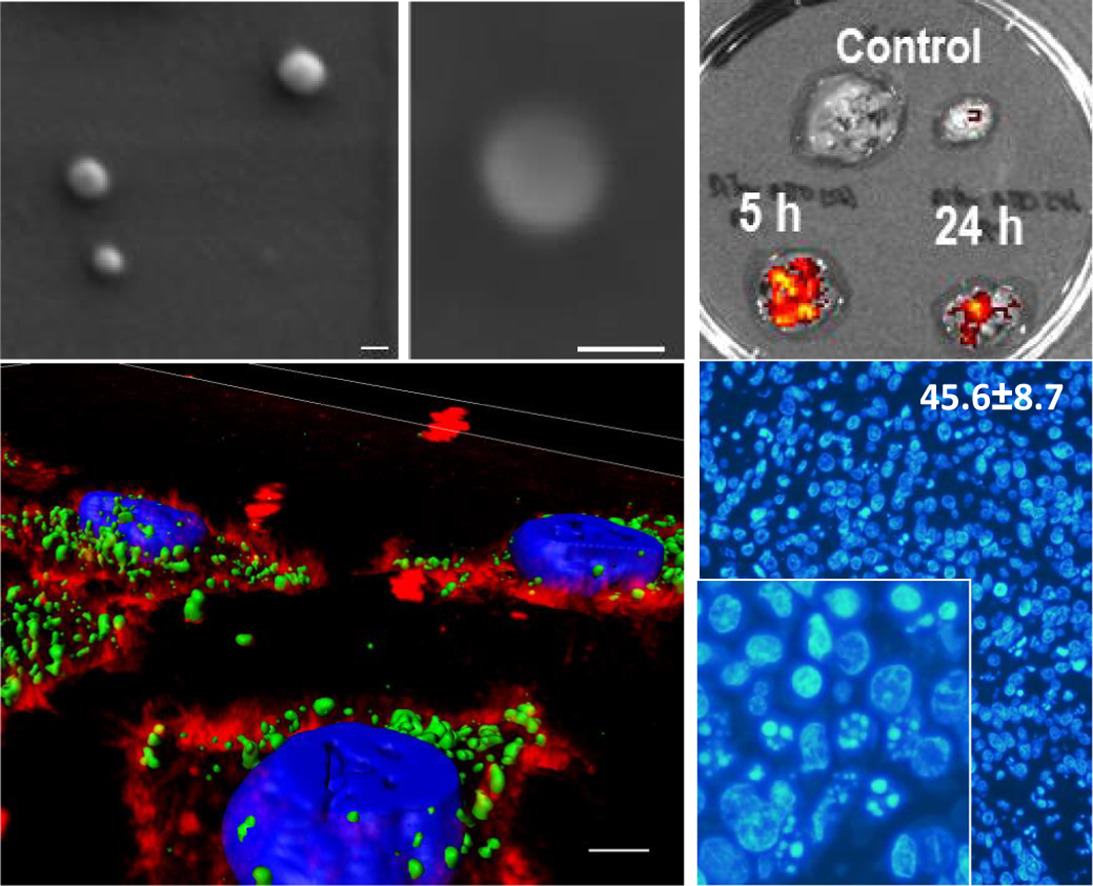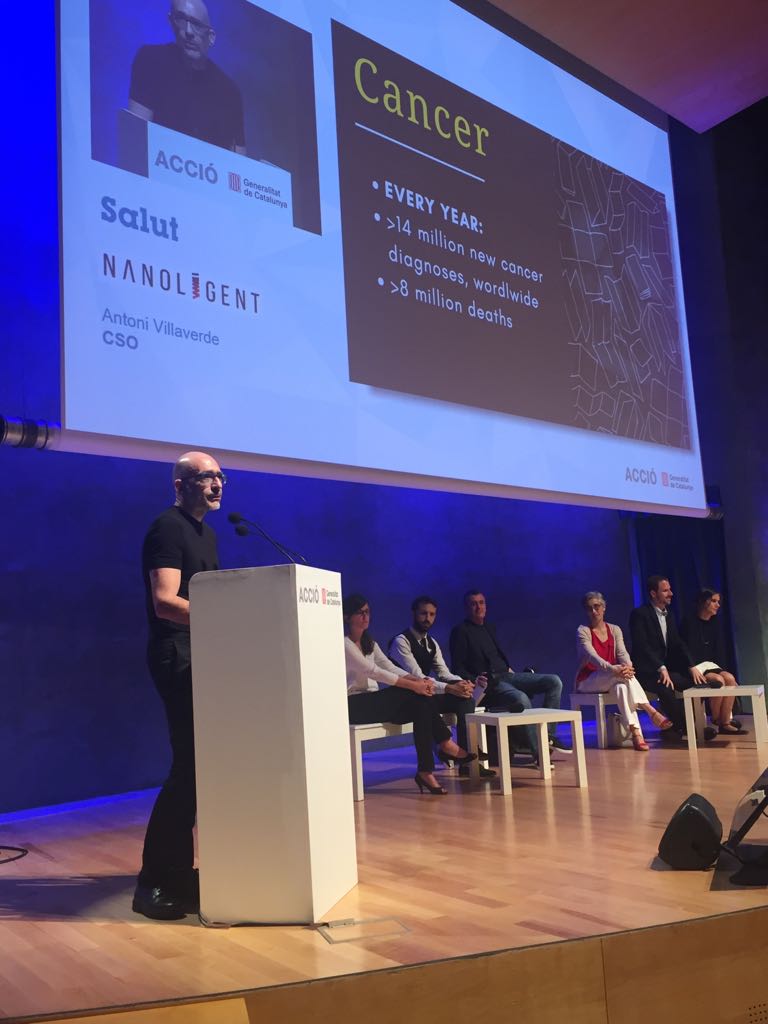How to optimize strategies to produce recombinant proteins?


The general consul of France in Barcelona, Mr. Cyril Piquemal visited the IBB UAB facilities last July 18, to find out about the research that is being carried out and, in particular, explore possible collaborations in nano-pharmacy development projects.
During the visit, the Consul of France in Barcelona was received by Màrius Martínez, Vice President of International Relations at the UAB; Maite Paramio, Deputy Vice President; Ivan Martínez, vice president of Research; Salvador Ventura, director of the Institute of Biotechnology and Biomedicine, and Antonio Villaverde, head of the IBB Nanotechnology Unit-NANBIOSIS U1. Protein Production Platform (PPP)
Next, the mayor visited the facilities and laboratories of the Institute and met with the researchers Esther Vázquez and Antonio Villaverde, (NANBIOSIS U1. Protein Production Platform (PPP)), and Ugutz Unzueta and Ramón Mangues, (NANBIOSIS Unit 18 Nanotoxicology Unit) at the Institute of Research of the ‘Hospital de la Santa Cruz and San Pablo, to find out about the research in the development of nanoparticles for metastases treatment by means of the selective elimination of tumor stem cells.
In addition, the researchers explained to the consul the case of the spin-off Nanoligent, to show a project born from the research and whose objective is to develop the first selective drug to treat metastasis
The purpose of the meeting was to explore possible collaborations between the University and the Consulate, an entity that aims to connect research groups and venture capital funds with the Catalan biotechnology ecosystem.

Nanoligent, S.L., the company stablished on March 2017 by professors Dr. A. Villaverde and Dra. E. Vázquez from NANBIOSIS Unit 1, professor Dr. M. Mangués from NANBIOSIS Unit 18, and entrepreneur Dr. M. Rodríguez is highlighted in la Vanguardia.
More information here

Researchers of NANBIOSIS Unit 1 and NANBIOSIS Unit 18, led by Prof Antoni Villaverde have published the article “Selective CXCR4+ Cancer Cell Targeting and Potent Antineoplastic Effect by a Nanostructured Version of Recombinant Ricin” at SMALL journal.
Under the unmet need of efficient tumor‐targeting drugs for oncology, a recombinant version of the plant toxin ricin (the modular protein T22‐mRTA‐H6) is engineered to self‐assemble as protein‐only, CXCR4‐targeted nanoparticles. The soluble version of the construct self‐organizes as regular 11 nm planar entities that are highly cytotoxic in cultured CXCR4+ cancer cells upon short time exposure, with a determined IC50 in the nanomolar order of magnitude. The chemical inhibition of CXCR4 binding sites in exposed cells results in a dramatic reduction of the cytotoxic potency, proving the receptor‐dependent mechanism of cytotoxicity. The insoluble version of T22‐mRTA‐H6 is, contrarily, moderately active, indicating that free, nanostructured protein is the optimal drug form. In animal models of acute myeloid leukemia, T22‐mRTA‐H6 nanoparticles show an impressive and highly selective therapeutic effect, dramatically reducing the leukemia cells affectation of clinically relevant organs. Functionalized T22‐mRTA‐H6 nanoparticles are then promising prototypes of chemically homogeneous, highly potent antitumor nanostructured toxins for precise oncotherapies based on self‐mediated intracellular drug delivery.
See article: https://doi.org/10.1002/smll.201800665

Scientists of NANBIOSIS Units U1. Protein Production Platform (PPP), and U18. Nanotoxicology Unit, have recently published an article titlled “Self-assembling toxin-based nanoparticles as self-delivered antitumoral drugs” in the Journal of Controlled Release.
Loading capacity and drug leakage from vehicles during circulation in blood is a major concern when developing nanoparticle-based cell-targeted cytotoxics. To circumvent this potential issue it would be convenient the engineering of drugs as self-delivered nanoscale entities, devoid of any heterologous carriers. In this context, we have here engineered potent protein toxins, namely segments of the diphtheria toxin and the Pseudomonas aeruginosa exotoxin as self-assembling, self-delivered therapeutic materials targeted to CXCR4+ cancer stem cells. The systemic administration of both nanostructured drugs in a colorectal cancer xenograft mouse model promotes efficient and specific local destruction of target tumor tissues and a significant reduction of the tumor volume. This observation strongly supports the concept of intrinsically functional protein nanoparticles, which having a dual role as drug and carrier, are designed to be administered without the assistance of heterologous vehicles.

Sustained release of drug delivery systems (DDS) has the capacity to increase cancer treatment efficiency in terms of drug dosage reduction and subsequent decrease of deleterious side effects. In this regard, many biomaterials are being investigated but none offers morphometric and functional plasticity and versatility comparable to protein-based nanoparticles (pNPs). Researchers of NANBIOSIS units 1 and 18 are co-authors of an article publish by Journal of Controlled Release in which it is described a new DDS by which pNPs are fabricated as bacterial inclusion bodies (IB), that can be easily isolated, subcutaneously injected and used as reservoirs for the sustained release of targeted pNPs. Our approach combines the high performance of pNP, regarding specific cell targeting and biodistribution with the IB supramolecular organization, stability and cost effectiveness. This renders a platform able to provide a sustained source of CXCR4-targeted pNPs that selectively accumulate in tumor cells in a CXCR4+ colorectal cancer xenograft model. In addition, the proposed system could be potentially adapted to any other protein construct offering a plethora of possible new therapeutic applications in nanomedicine.
In the study the researchers have generated novel smart biomaterials gathering most of the desirable features for implantable DDS, with cost effectiveness and simplicity in the biofabrication process. In this regard, single step fabricated IBs when injected subcutaneously rendered a long lasting release of targeted pNPs, able to enter to the blood stream and specifically target the tumor for as long as 10 days and they have described for the first time an approach for the fabrication of protein DDS based on protein deposition as IBs and their sustained release in form of fully functional targeted pNPs. This technology provides and stable source of targeted protein nanoparticles during long periods within the body with the action at distal points from the implantation site and pave the way for the appearance of new more efficient and less invasive treatments for a broad number of pathologies.
Protein production has been partially performed by the ICTS “NANBIOSIS”, more specifically by the U1. Protein Production Platform (PPP), whereas the in vivo biodistribution assays were performed in the NANBIOSIS U18. Nanotoxicology Unit,
For further information see https://sciencedirect.com/science/article/pii/S0168365918301780?via%3Dihub

Scientists of Units 1 and 18 of NANBIOSIS are coathors of the article “Switching cell penetrating and CXCR4-binding activities of nanoscale-organized arginine-rich peptides” published by Nanomedicine: Nanotechnology, Biology and Medicine
Arginine-rich protein motifs have been described as potent cell-penetrating peptides (CPPs) but also as rather specific ligands of the cell surface chemokine receptor CXCR4, involved in the infection by the human immunodeficiency virus (HIV).
Polyarginines are commonly used to functionalize nanoscale vehicles for gene therapy and drug delivery, aimed to enhance cell penetrability of the therapeutic cargo. However, under which conditions these peptides do act as either unspecific or specific ligands is unknown. The authors have here explored the cell penetrability of differently charged polyarginines in two alternative presentations, namely as unassembled fusion proteins or assembled in multimeric protein nanoparticles. By this, they have observed that arginine-rich peptides switch between receptor-mediated and receptor-independent mechanisms of cell penetration. The relative weight of these activities is determined by the electrostatic charge of the construct and the oligomerizationstatus of the nanoscale material, both regulatable by conventional protein engineering approaches
Protein production has been partially performed by the ICTS “NANBIOSIS”, more specifically by the U1. Protein Production Platform (PPP), whereas the in vivo biodistribution assays were performed in the NANBIOSIS U18. Nanotoxicology Unit,
Article of reference:

Last June 21-22th, took place at the Fira Gran Via in Barcelona, the ONCO Emergence forum, a networking conference focused on setting up transnational collaboration projects in oncology by promoting interaction among research institutes, companies and medical facilities like hospitals.
In other to promote alliances and generate collaborative projects from hospitals and academia to other stakeholders, ONCO Emergence Forum Barcelona has created a Tech Transfer Competition that features cherry-picked entrepreneurs, TTO or principal investigators developing new technology ready to be licensed or in development through a spin-off. Selected participants presented their innovative projects in a 6-minute English pitch to an experienced panel of judges, being the prize €1,500, provided by Fundación Pública Andaluza Parque Tecnológico de la Salud de Granada. The competition target are therapeutic, diagnostic, medtech and digital health projects in oncology within the framework of improving healthcare and medical assistance with a deep focus on an unmet medical/market/patient need, resolved through an innovative technology to create a product or service; project must be in TLR 2-4 with tested hypothesis and demonstrated proof-of-concept as well as safety in in vitro/animal model.
NANOLIGENT, the spin off created by the Directors of NANBIOSIS Units U1. Protein Production Platform (PPP), Antoni Villaverde and U18. Nanotoxicology Unit, Ramón Mangues, together with Esther Vázquez and Manuel Rodriguez, was awarded with the First Prize.
Nanoligent´s project is about antimetastatic medication for colorectal cancer and its business model is carrying out a first clinical trial which demonstrates the efficacy of the medication in humans and allows the company to sign a license agreement with a pharmaceutical company.

NANOLIGENT is awarded for the best company in Health Sciences Price given by the law firm RCD.
The XXIII Investment Forum of ACCIÓ 2018 was celebrated last June 20th with the aim of connecting with the world of private investment. ACCIÓ, Company Competitiveness Agency, had previously published a catalog of startups with the most potential startups in Catalonia, projects selected from more than 100 candidatures were presented for the 2018 Investment Forum of ACTION. The 50 companies in this catalog stand out due to their differential nature and innovative value, due to their social impact and the involvement of the entrepreneurial team. They are companies operating in key sectors for the economy of the future such as life and health sciences, ICT and other crucial cutting-edge technologies for industry 4.0 including 3D printing, IoT and virtual reality. The 21 finalists had the opportunity to present themselves to a large number of investors and venture capital funds during the Forum’s celebration, an audience of 600 people who voted the 9 best companies to participate in the final. Nanoligent, S.L., the company stablished on March 2017 by professors Dr. A. Villaverde and Dra. E. Vázquez from NANBIOSIS Unit 1, professor Dr. M. Mangués from NANBIOSIS Unit 18, and entrepreneur Dr. M. Rodríguez won the award for the best company in Health Sciences given by the law firm RCD (Rousaud Costas Duran)
NANOLIGENT’s mission is to improve the lives of patients by designing new medications that selectively target the cells affected by disease. With this approach NANOLIGENT develops treatments that are more effective and have less adverse effects than classical drugs using state-of-the-art protein engineering and nanobiotechnology. Currently Nanoligent is working on antimetastatic medication for colorectal cancer and its business model is carrying out a first clinical trial which demonstrates the efficacy of the medication in humans and allows the company to sign a license agreement with a pharmaceutical company

NANBIOSIS researchers have developed a nanomedicine for the treatment of metastases by the selective elimination of tumor stem cells. It is a system based on nanoparticles that transport a chemotherapeutic drug and release it into cancer cells.
The research team, led by Esther Vázquez and Antonio Villaverde, Strategy Director of NANBIOSIS U1. Protein Production Platform (PPP), in the IBB-UAB, and Ramon Mangues, Scientific Director of NANBIOSIS U18. Nanotoxicology Unit, in the Sant Pau Hospital, have already created a prototype of the drug and have conducted in vivo trials in animal models of colorectal cancer. They have demonstrated their effectiveness, selective biodistribution and low toxicity.
To promote the development of the drug towards the clinic, the reserachers have created Nanoligent a start-up company, based in Barcelona, led by Manuel Rodríguez, a professional with experience in the field of investment and the creation and growth of biotech companies. The technology is patented in Europe and USA and has been licenced to Nanoligent
The therapy created by the researchers is aimed at blocking the development of metastasis, mainly of colorectal cancer, through new strategies aimed at certain cell types. It consists of a new drug administration system based on protein nanoparticles that selectively conduct the therapeutic agent in tumor cells. The drug acts only on cancer cells, because it is based on the specific interaction between a protein present in the nanoparticle and a cellular receptor (CXCR4), which is overexpressed in tumor cells. “This interaction is crucial, because it allows attacking only tumor cells and not healthy cells, thus avoiding secondary effects derived from classical chemotherapy,” emphasizes Antonio Villaverde.
The CXCR4 receptor is overexpressed in many types of tumors, so that “this technology can be directed to the treatment of different types of neoplasms in addition to colorectal cancer and derived metastases, such as lymphoma, leukemia or endometrial cancer, in animal models already available to the group of Sant Pau “, comments Ramon Mangues. In addition, nanoparticles are compatible with a huge variety of possible drugs and therefore they become highly versatile vehicles that can carry a wide range of therapeutic molecules.
“There is an urgent need for more effective and personalized treatments for cancer. The toxicity and the lack of efficacy of conventional drugs are pushing alternative experimental strategies directed and designed to achieve only defined cell types. Nanoparticles, thanks to their capacity for penetration, dissemination and functionality, offer a promising nanomedical landscape to create new drugs,” explains Esther Vázquez.
“In this direction, the technology of Nanoligent opens a new door in anti-pelagic therapy, as it allows to design a treatment with greater cellular specificity than that of existing treatments, while offering greater biosecurity and biodegradability and lower toxicity,” he said. Antonio Villaverde points out.
Currently, there are no drugs in the market that selectively eliminate metastatic stem cells. Although Nanoligent technology is still under development, researchers say they have a lot of potential and consider that it could have a high clinical impact as regulatory trials are overcome.

